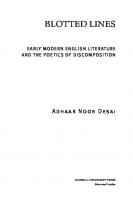Poetics of the Pillory: English Literature and Seditious Libel, 1660-1820 (Clarendon Lectures in English) 9780198744498, 0198744498
On the lapse of the Licensing Act in 1695, Thomas Macaulay wrote in his History of England, 'English literature was
114 84 4MB
English Pages 352 [343]
Table of contents :
Cover
Poetics of the Pillory: English Literature and Seditious Libel, 1660–1820
Copyright
Dedicatiion
Acknowledgements
Contents
List of Illustrations
List of Abbreviations
Introduction
1: 1660–1700 Faint Meaning: Dryden and Restoration Censorship
Strange elegy: Lachrymae musarum, Heroic Stanzas
Panegyric in print and script, Astraea Redux to Mac Flecknoe
Plays and parallels: Exclusion Crisis libel and the licensing lapse
Fable, history, translation: scourging by proxy
2: 1700–1740 Libels in Hieroglyphics: Pope, Defoe
Earless in Grubstreet
Wit, and punishment, and Pope: The Dunciad and after
Irony, intention, interpretation: The Shortest Way with the Dissenters
Defoe in the pillory
Allegoric histories: Windsor Forest, Robinson Crusoe
3: 1730–1780 The Trade of Libelling: Fielding, Johnson
Defeating the pillory: Mist, Curll, Shebbeare, Wilkes
Performance and print under Walpole
Fielding and Walpole: the art of thriving
Lives of the opposition poets
Johnsonian sedition: London, Marmor Norfolciense
4: 1780–1820 Southey’s New Star Chamber: Literature, Revolution, and Romantic-Era Libel
Allegories, parodies, polemics: Walter Cox, William Hone, and others
The ‘King Chaunticlere’ trial: arbitrary innuendo and necessary sense
Trumpets of sedition?
Censorship, copyright, and Wat Tyler
The most seditious book that was ever written
Conclusion: England in 1820
Select Bibliography
Index
Пустая страница
Пустая страница
Cover
Poetics of the Pillory: English Literature and Seditious Libel, 1660–1820
Copyright
Dedicatiion
Acknowledgements
Contents
List of Illustrations
List of Abbreviations
Introduction
1: 1660–1700 Faint Meaning: Dryden and Restoration Censorship
Strange elegy: Lachrymae musarum, Heroic Stanzas
Panegyric in print and script, Astraea Redux to Mac Flecknoe
Plays and parallels: Exclusion Crisis libel and the licensing lapse
Fable, history, translation: scourging by proxy
2: 1700–1740 Libels in Hieroglyphics: Pope, Defoe
Earless in Grubstreet
Wit, and punishment, and Pope: The Dunciad and after
Irony, intention, interpretation: The Shortest Way with the Dissenters
Defoe in the pillory
Allegoric histories: Windsor Forest, Robinson Crusoe
3: 1730–1780 The Trade of Libelling: Fielding, Johnson
Defeating the pillory: Mist, Curll, Shebbeare, Wilkes
Performance and print under Walpole
Fielding and Walpole: the art of thriving
Lives of the opposition poets
Johnsonian sedition: London, Marmor Norfolciense
4: 1780–1820 Southey’s New Star Chamber: Literature, Revolution, and Romantic-Era Libel
Allegories, parodies, polemics: Walter Cox, William Hone, and others
The ‘King Chaunticlere’ trial: arbitrary innuendo and necessary sense
Trumpets of sedition?
Censorship, copyright, and Wat Tyler
The most seditious book that was ever written
Conclusion: England in 1820
Select Bibliography
Index
Пустая страница
Пустая страница

- Author / Uploaded
- Thomas Keymer







![The Law's Two Bodies: Some Evidential Problems in English Legal History (Clarendon Law Lectures) [1 ed.]
0199245185, 9780199245185](https://ebin.pub/img/200x200/the-laws-two-bodies-some-evidential-problems-in-english-legal-history-clarendon-law-lectures-1nbsped-0199245185-9780199245185.jpg)

